Analyzing the Influence of Environment on TESCO PLC
VerifiedAdded on 2023/01/11
|15
|5000
|93
AI Summary
This article provides a strategic analysis of TESCO PLC, focusing on the influence of the environment on the company. It includes a PESTLE analysis and stakeholder analysis, as well as an evaluation of the internal environment and capabilities using VRIO analysis. The article also discusses the outcomes of Porter's Five Forces model in relation to TESCO PLC.
Contribute Materials
Your contribution can guide someone’s learning journey. Share your
documents today.
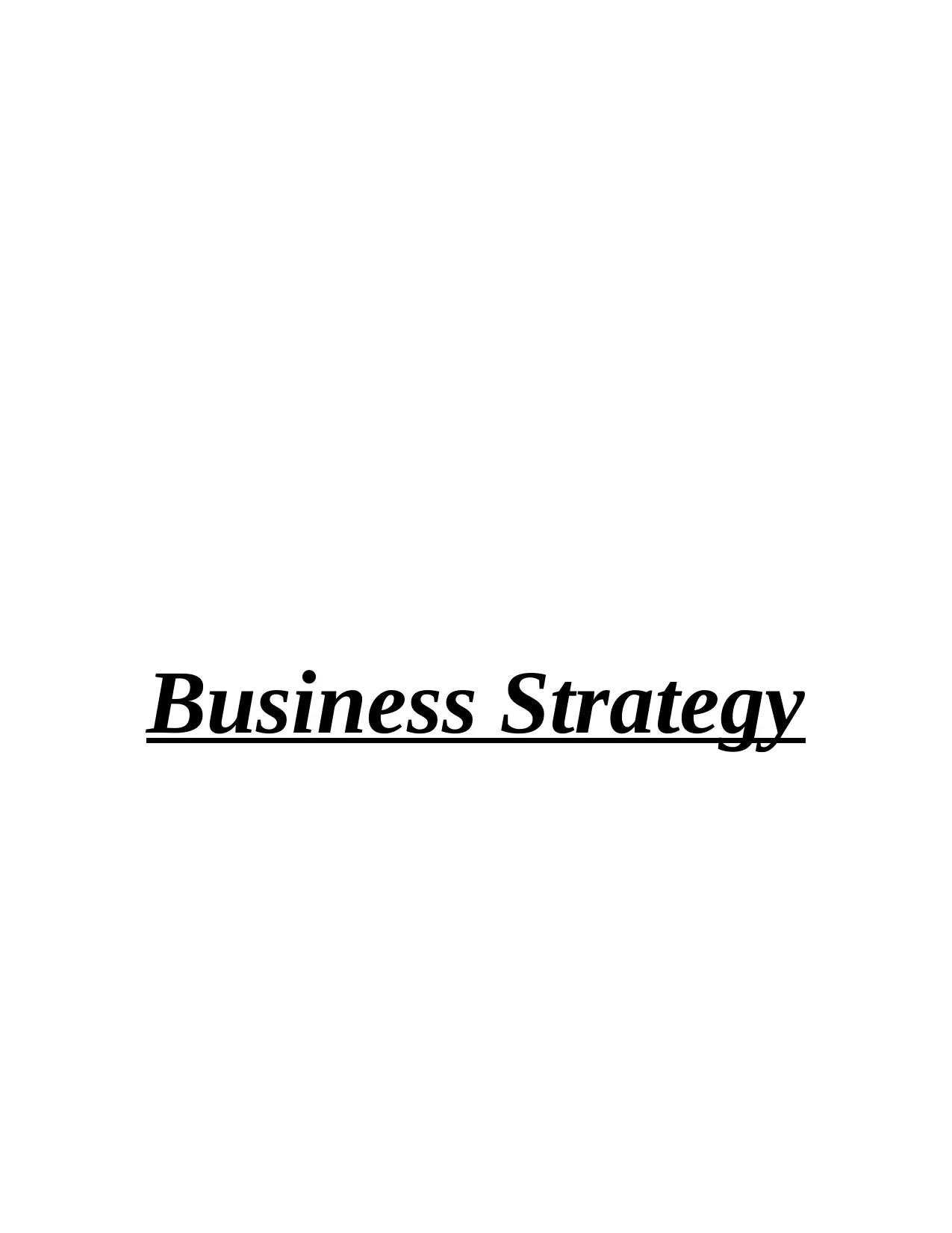
Business Strategy
Secure Best Marks with AI Grader
Need help grading? Try our AI Grader for instant feedback on your assignments.
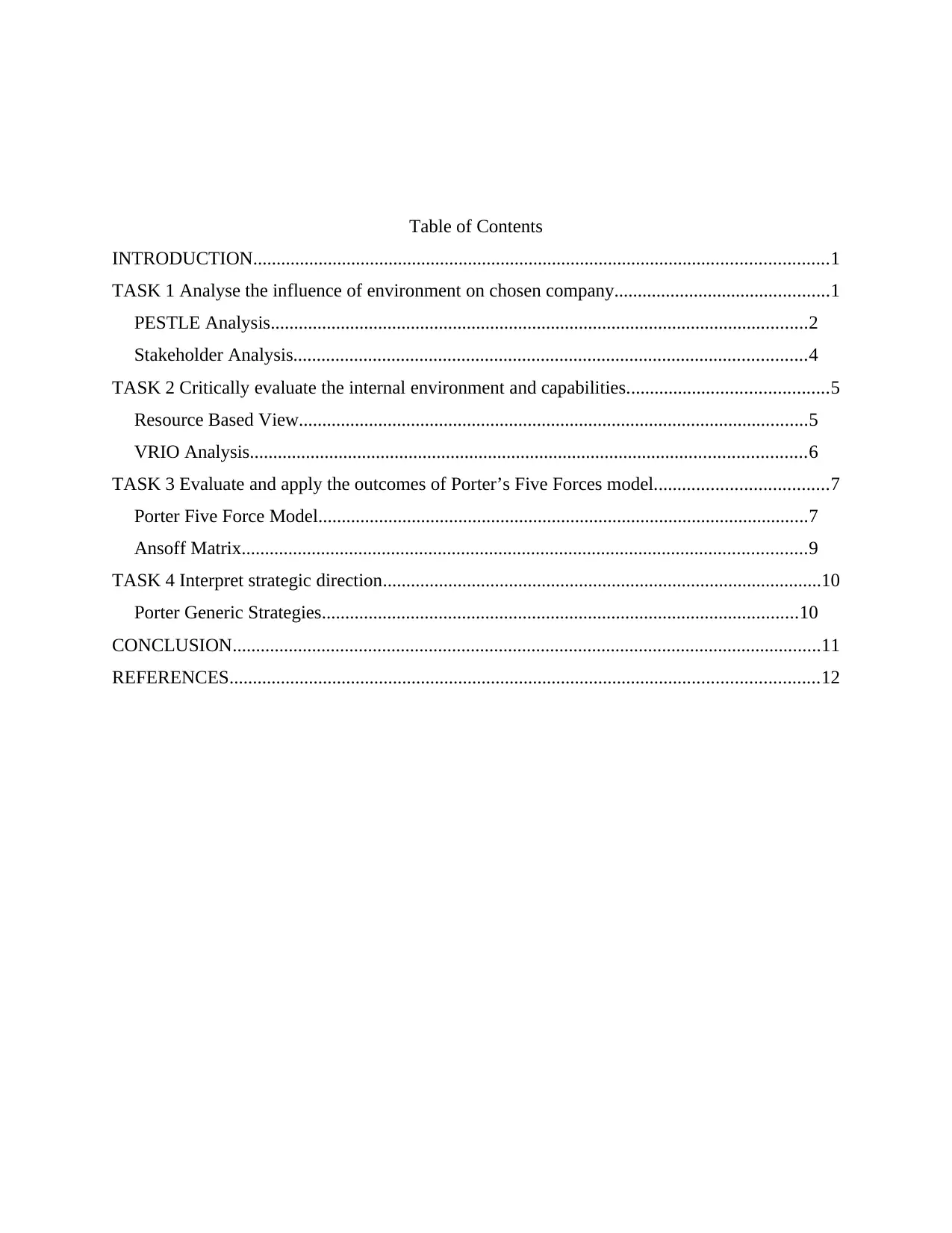
Table of Contents
INTRODUCTION...........................................................................................................................1
TASK 1 Analyse the influence of environment on chosen company..............................................1
PESTLE Analysis...................................................................................................................2
Stakeholder Analysis..............................................................................................................4
TASK 2 Critically evaluate the internal environment and capabilities...........................................5
Resource Based View.............................................................................................................5
VRIO Analysis.......................................................................................................................6
TASK 3 Evaluate and apply the outcomes of Porter’s Five Forces model.....................................7
Porter Five Force Model.........................................................................................................7
Ansoff Matrix.........................................................................................................................9
TASK 4 Interpret strategic direction..............................................................................................10
Porter Generic Strategies......................................................................................................10
CONCLUSION..............................................................................................................................11
REFERENCES..............................................................................................................................12
INTRODUCTION...........................................................................................................................1
TASK 1 Analyse the influence of environment on chosen company..............................................1
PESTLE Analysis...................................................................................................................2
Stakeholder Analysis..............................................................................................................4
TASK 2 Critically evaluate the internal environment and capabilities...........................................5
Resource Based View.............................................................................................................5
VRIO Analysis.......................................................................................................................6
TASK 3 Evaluate and apply the outcomes of Porter’s Five Forces model.....................................7
Porter Five Force Model.........................................................................................................7
Ansoff Matrix.........................................................................................................................9
TASK 4 Interpret strategic direction..............................................................................................10
Porter Generic Strategies......................................................................................................10
CONCLUSION..............................................................................................................................11
REFERENCES..............................................................................................................................12
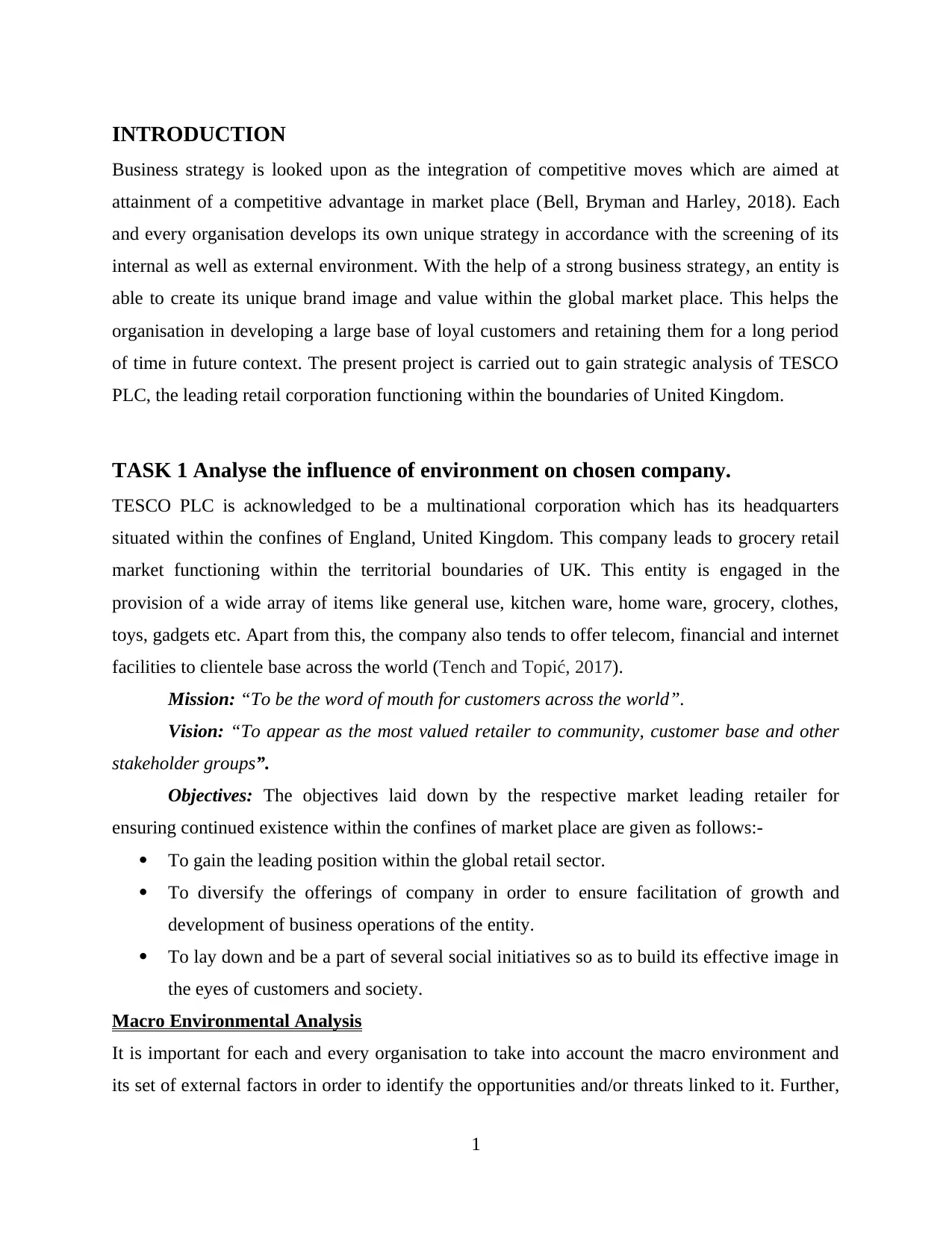
INTRODUCTION
Business strategy is looked upon as the integration of competitive moves which are aimed at
attainment of a competitive advantage in market place (Bell, Bryman and Harley, 2018). Each
and every organisation develops its own unique strategy in accordance with the screening of its
internal as well as external environment. With the help of a strong business strategy, an entity is
able to create its unique brand image and value within the global market place. This helps the
organisation in developing a large base of loyal customers and retaining them for a long period
of time in future context. The present project is carried out to gain strategic analysis of TESCO
PLC, the leading retail corporation functioning within the boundaries of United Kingdom.
TASK 1 Analyse the influence of environment on chosen company.
TESCO PLC is acknowledged to be a multinational corporation which has its headquarters
situated within the confines of England, United Kingdom. This company leads to grocery retail
market functioning within the territorial boundaries of UK. This entity is engaged in the
provision of a wide array of items like general use, kitchen ware, home ware, grocery, clothes,
toys, gadgets etc. Apart from this, the company also tends to offer telecom, financial and internet
facilities to clientele base across the world (Tench and Topić, 2017).
Mission: “To be the word of mouth for customers across the world”.
Vision: “To appear as the most valued retailer to community, customer base and other
stakeholder groups”.
Objectives: The objectives laid down by the respective market leading retailer for
ensuring continued existence within the confines of market place are given as follows:-
To gain the leading position within the global retail sector.
To diversify the offerings of company in order to ensure facilitation of growth and
development of business operations of the entity.
To lay down and be a part of several social initiatives so as to build its effective image in
the eyes of customers and society.
Macro Environmental Analysis
It is important for each and every organisation to take into account the macro environment and
its set of external factors in order to identify the opportunities and/or threats linked to it. Further,
1
Business strategy is looked upon as the integration of competitive moves which are aimed at
attainment of a competitive advantage in market place (Bell, Bryman and Harley, 2018). Each
and every organisation develops its own unique strategy in accordance with the screening of its
internal as well as external environment. With the help of a strong business strategy, an entity is
able to create its unique brand image and value within the global market place. This helps the
organisation in developing a large base of loyal customers and retaining them for a long period
of time in future context. The present project is carried out to gain strategic analysis of TESCO
PLC, the leading retail corporation functioning within the boundaries of United Kingdom.
TASK 1 Analyse the influence of environment on chosen company.
TESCO PLC is acknowledged to be a multinational corporation which has its headquarters
situated within the confines of England, United Kingdom. This company leads to grocery retail
market functioning within the territorial boundaries of UK. This entity is engaged in the
provision of a wide array of items like general use, kitchen ware, home ware, grocery, clothes,
toys, gadgets etc. Apart from this, the company also tends to offer telecom, financial and internet
facilities to clientele base across the world (Tench and Topić, 2017).
Mission: “To be the word of mouth for customers across the world”.
Vision: “To appear as the most valued retailer to community, customer base and other
stakeholder groups”.
Objectives: The objectives laid down by the respective market leading retailer for
ensuring continued existence within the confines of market place are given as follows:-
To gain the leading position within the global retail sector.
To diversify the offerings of company in order to ensure facilitation of growth and
development of business operations of the entity.
To lay down and be a part of several social initiatives so as to build its effective image in
the eyes of customers and society.
Macro Environmental Analysis
It is important for each and every organisation to take into account the macro environment and
its set of external factors in order to identify the opportunities and/or threats linked to it. Further,
1
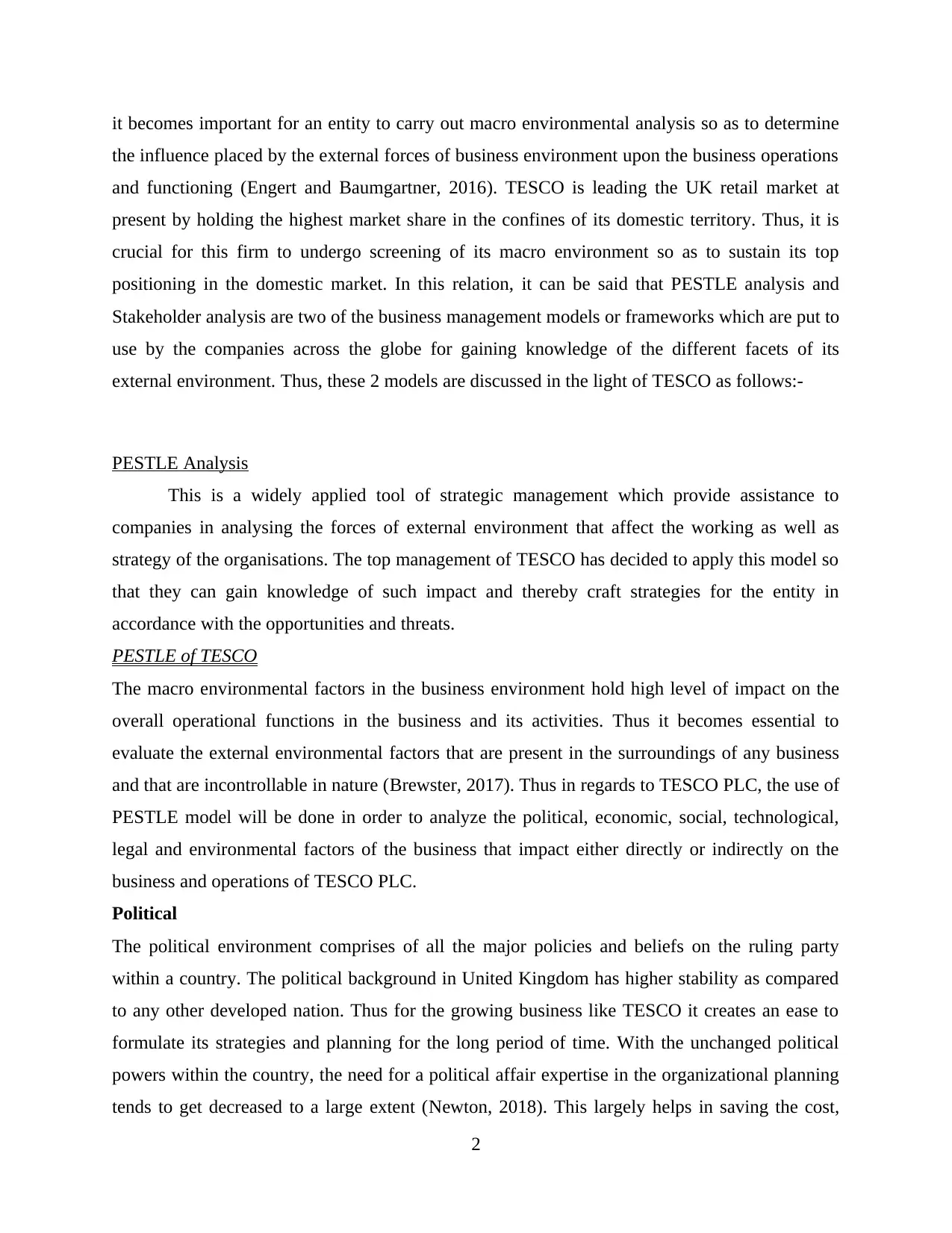
it becomes important for an entity to carry out macro environmental analysis so as to determine
the influence placed by the external forces of business environment upon the business operations
and functioning (Engert and Baumgartner, 2016). TESCO is leading the UK retail market at
present by holding the highest market share in the confines of its domestic territory. Thus, it is
crucial for this firm to undergo screening of its macro environment so as to sustain its top
positioning in the domestic market. In this relation, it can be said that PESTLE analysis and
Stakeholder analysis are two of the business management models or frameworks which are put to
use by the companies across the globe for gaining knowledge of the different facets of its
external environment. Thus, these 2 models are discussed in the light of TESCO as follows:-
PESTLE Analysis
This is a widely applied tool of strategic management which provide assistance to
companies in analysing the forces of external environment that affect the working as well as
strategy of the organisations. The top management of TESCO has decided to apply this model so
that they can gain knowledge of such impact and thereby craft strategies for the entity in
accordance with the opportunities and threats.
PESTLE of TESCO
The macro environmental factors in the business environment hold high level of impact on the
overall operational functions in the business and its activities. Thus it becomes essential to
evaluate the external environmental factors that are present in the surroundings of any business
and that are incontrollable in nature (Brewster, 2017). Thus in regards to TESCO PLC, the use of
PESTLE model will be done in order to analyze the political, economic, social, technological,
legal and environmental factors of the business that impact either directly or indirectly on the
business and operations of TESCO PLC.
Political
The political environment comprises of all the major policies and beliefs on the ruling party
within a country. The political background in United Kingdom has higher stability as compared
to any other developed nation. Thus for the growing business like TESCO it creates an ease to
formulate its strategies and planning for the long period of time. With the unchanged political
powers within the country, the need for a political affair expertise in the organizational planning
tends to get decreased to a large extent (Newton, 2018). This largely helps in saving the cost,
2
the influence placed by the external forces of business environment upon the business operations
and functioning (Engert and Baumgartner, 2016). TESCO is leading the UK retail market at
present by holding the highest market share in the confines of its domestic territory. Thus, it is
crucial for this firm to undergo screening of its macro environment so as to sustain its top
positioning in the domestic market. In this relation, it can be said that PESTLE analysis and
Stakeholder analysis are two of the business management models or frameworks which are put to
use by the companies across the globe for gaining knowledge of the different facets of its
external environment. Thus, these 2 models are discussed in the light of TESCO as follows:-
PESTLE Analysis
This is a widely applied tool of strategic management which provide assistance to
companies in analysing the forces of external environment that affect the working as well as
strategy of the organisations. The top management of TESCO has decided to apply this model so
that they can gain knowledge of such impact and thereby craft strategies for the entity in
accordance with the opportunities and threats.
PESTLE of TESCO
The macro environmental factors in the business environment hold high level of impact on the
overall operational functions in the business and its activities. Thus it becomes essential to
evaluate the external environmental factors that are present in the surroundings of any business
and that are incontrollable in nature (Brewster, 2017). Thus in regards to TESCO PLC, the use of
PESTLE model will be done in order to analyze the political, economic, social, technological,
legal and environmental factors of the business that impact either directly or indirectly on the
business and operations of TESCO PLC.
Political
The political environment comprises of all the major policies and beliefs on the ruling party
within a country. The political background in United Kingdom has higher stability as compared
to any other developed nation. Thus for the growing business like TESCO it creates an ease to
formulate its strategies and planning for the long period of time. With the unchanged political
powers within the country, the need for a political affair expertise in the organizational planning
tends to get decreased to a large extent (Newton, 2018). This largely helps in saving the cost,
2
Secure Best Marks with AI Grader
Need help grading? Try our AI Grader for instant feedback on your assignments.
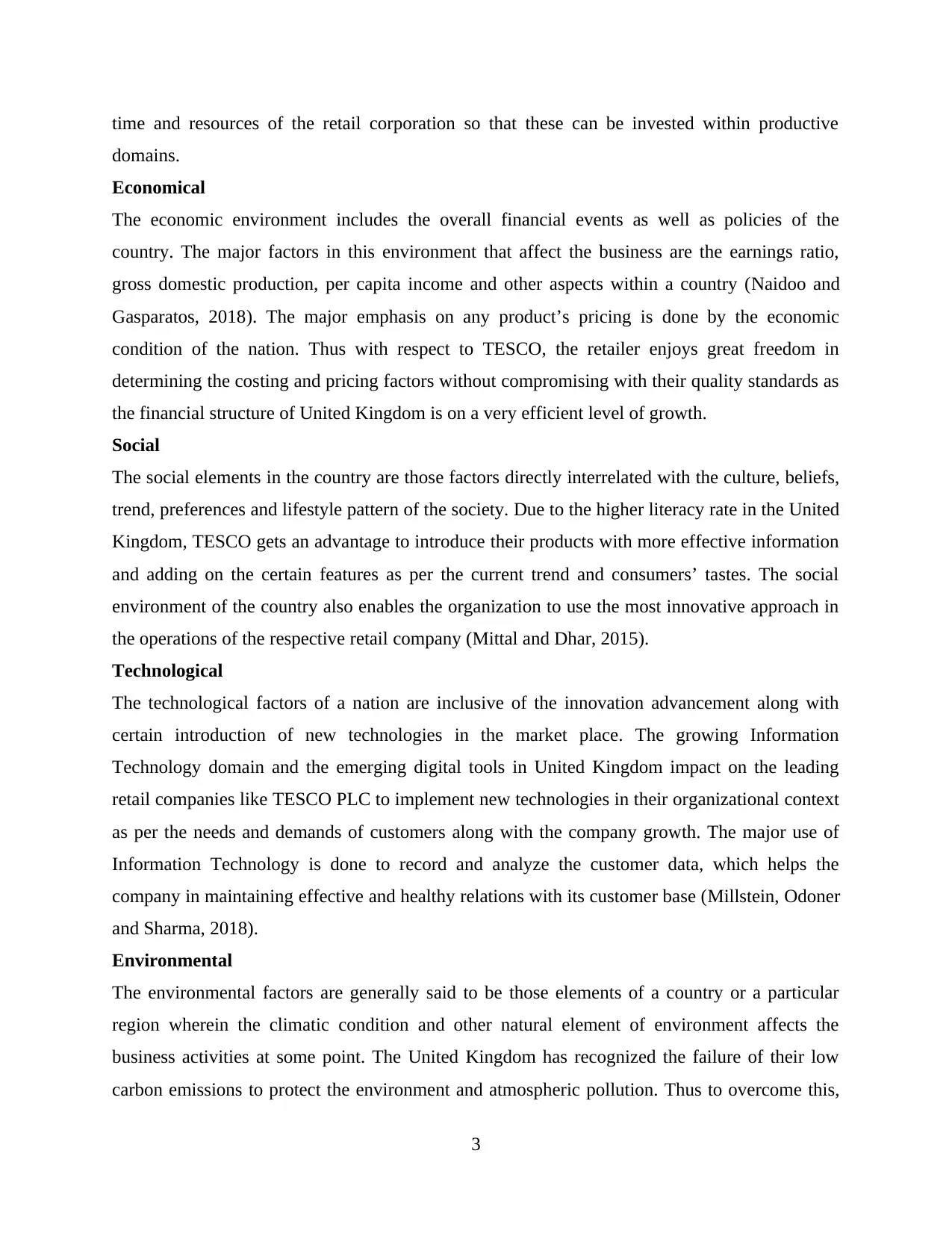
time and resources of the retail corporation so that these can be invested within productive
domains.
Economical
The economic environment includes the overall financial events as well as policies of the
country. The major factors in this environment that affect the business are the earnings ratio,
gross domestic production, per capita income and other aspects within a country (Naidoo and
Gasparatos, 2018). The major emphasis on any product’s pricing is done by the economic
condition of the nation. Thus with respect to TESCO, the retailer enjoys great freedom in
determining the costing and pricing factors without compromising with their quality standards as
the financial structure of United Kingdom is on a very efficient level of growth.
Social
The social elements in the country are those factors directly interrelated with the culture, beliefs,
trend, preferences and lifestyle pattern of the society. Due to the higher literacy rate in the United
Kingdom, TESCO gets an advantage to introduce their products with more effective information
and adding on the certain features as per the current trend and consumers’ tastes. The social
environment of the country also enables the organization to use the most innovative approach in
the operations of the respective retail company (Mittal and Dhar, 2015).
Technological
The technological factors of a nation are inclusive of the innovation advancement along with
certain introduction of new technologies in the market place. The growing Information
Technology domain and the emerging digital tools in United Kingdom impact on the leading
retail companies like TESCO PLC to implement new technologies in their organizational context
as per the needs and demands of customers along with the company growth. The major use of
Information Technology is done to record and analyze the customer data, which helps the
company in maintaining effective and healthy relations with its customer base (Millstein, Odoner
and Sharma, 2018).
Environmental
The environmental factors are generally said to be those elements of a country or a particular
region wherein the climatic condition and other natural element of environment affects the
business activities at some point. The United Kingdom has recognized the failure of their low
carbon emissions to protect the environment and atmospheric pollution. Thus to overcome this,
3
domains.
Economical
The economic environment includes the overall financial events as well as policies of the
country. The major factors in this environment that affect the business are the earnings ratio,
gross domestic production, per capita income and other aspects within a country (Naidoo and
Gasparatos, 2018). The major emphasis on any product’s pricing is done by the economic
condition of the nation. Thus with respect to TESCO, the retailer enjoys great freedom in
determining the costing and pricing factors without compromising with their quality standards as
the financial structure of United Kingdom is on a very efficient level of growth.
Social
The social elements in the country are those factors directly interrelated with the culture, beliefs,
trend, preferences and lifestyle pattern of the society. Due to the higher literacy rate in the United
Kingdom, TESCO gets an advantage to introduce their products with more effective information
and adding on the certain features as per the current trend and consumers’ tastes. The social
environment of the country also enables the organization to use the most innovative approach in
the operations of the respective retail company (Mittal and Dhar, 2015).
Technological
The technological factors of a nation are inclusive of the innovation advancement along with
certain introduction of new technologies in the market place. The growing Information
Technology domain and the emerging digital tools in United Kingdom impact on the leading
retail companies like TESCO PLC to implement new technologies in their organizational context
as per the needs and demands of customers along with the company growth. The major use of
Information Technology is done to record and analyze the customer data, which helps the
company in maintaining effective and healthy relations with its customer base (Millstein, Odoner
and Sharma, 2018).
Environmental
The environmental factors are generally said to be those elements of a country or a particular
region wherein the climatic condition and other natural element of environment affects the
business activities at some point. The United Kingdom has recognized the failure of their low
carbon emissions to protect the environment and atmospheric pollution. Thus to overcome this,
3
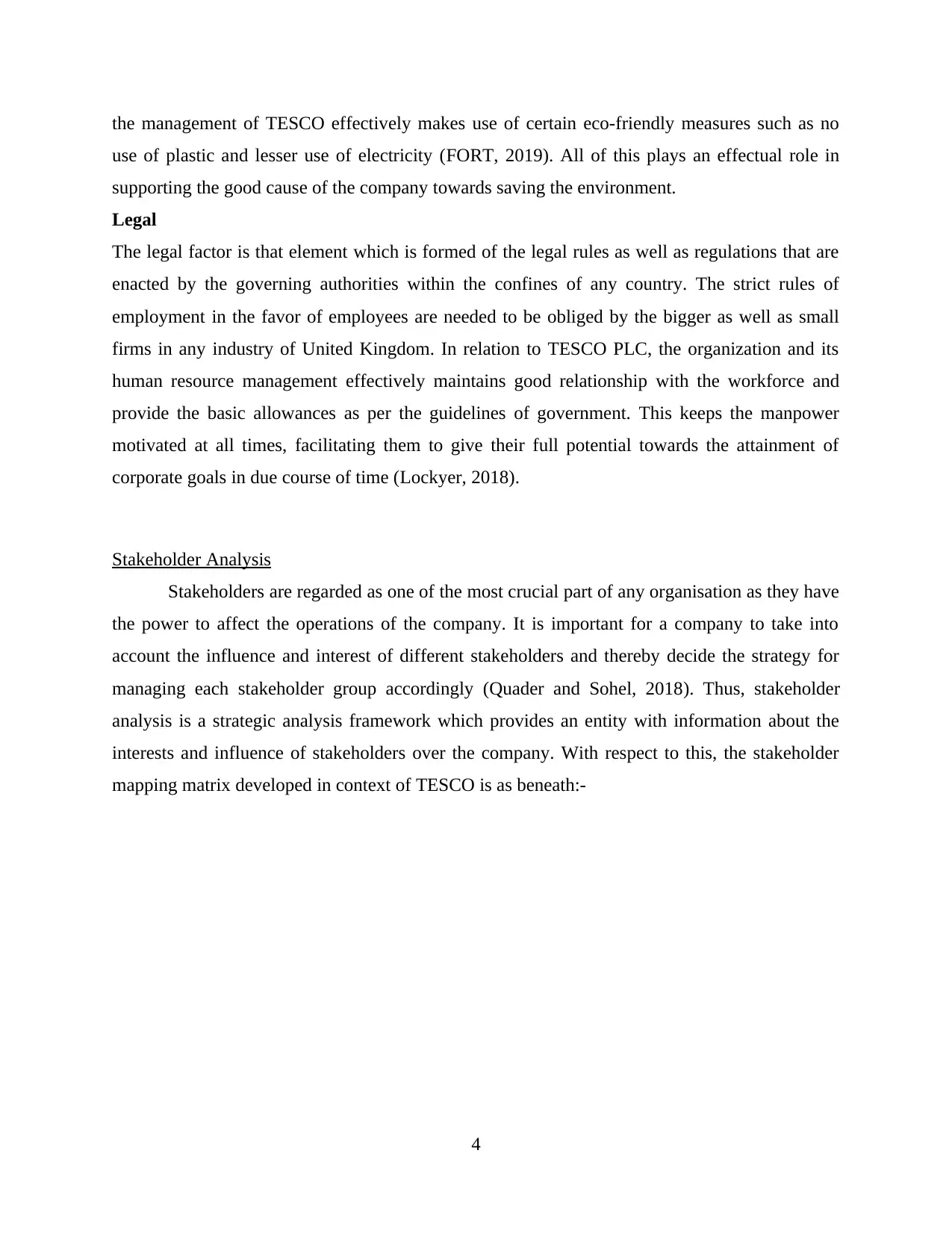
the management of TESCO effectively makes use of certain eco-friendly measures such as no
use of plastic and lesser use of electricity (FORT, 2019). All of this plays an effectual role in
supporting the good cause of the company towards saving the environment.
Legal
The legal factor is that element which is formed of the legal rules as well as regulations that are
enacted by the governing authorities within the confines of any country. The strict rules of
employment in the favor of employees are needed to be obliged by the bigger as well as small
firms in any industry of United Kingdom. In relation to TESCO PLC, the organization and its
human resource management effectively maintains good relationship with the workforce and
provide the basic allowances as per the guidelines of government. This keeps the manpower
motivated at all times, facilitating them to give their full potential towards the attainment of
corporate goals in due course of time (Lockyer, 2018).
Stakeholder Analysis
Stakeholders are regarded as one of the most crucial part of any organisation as they have
the power to affect the operations of the company. It is important for a company to take into
account the influence and interest of different stakeholders and thereby decide the strategy for
managing each stakeholder group accordingly (Quader and Sohel, 2018). Thus, stakeholder
analysis is a strategic analysis framework which provides an entity with information about the
interests and influence of stakeholders over the company. With respect to this, the stakeholder
mapping matrix developed in context of TESCO is as beneath:-
4
use of plastic and lesser use of electricity (FORT, 2019). All of this plays an effectual role in
supporting the good cause of the company towards saving the environment.
Legal
The legal factor is that element which is formed of the legal rules as well as regulations that are
enacted by the governing authorities within the confines of any country. The strict rules of
employment in the favor of employees are needed to be obliged by the bigger as well as small
firms in any industry of United Kingdom. In relation to TESCO PLC, the organization and its
human resource management effectively maintains good relationship with the workforce and
provide the basic allowances as per the guidelines of government. This keeps the manpower
motivated at all times, facilitating them to give their full potential towards the attainment of
corporate goals in due course of time (Lockyer, 2018).
Stakeholder Analysis
Stakeholders are regarded as one of the most crucial part of any organisation as they have
the power to affect the operations of the company. It is important for a company to take into
account the influence and interest of different stakeholders and thereby decide the strategy for
managing each stakeholder group accordingly (Quader and Sohel, 2018). Thus, stakeholder
analysis is a strategic analysis framework which provides an entity with information about the
interests and influence of stakeholders over the company. With respect to this, the stakeholder
mapping matrix developed in context of TESCO is as beneath:-
4
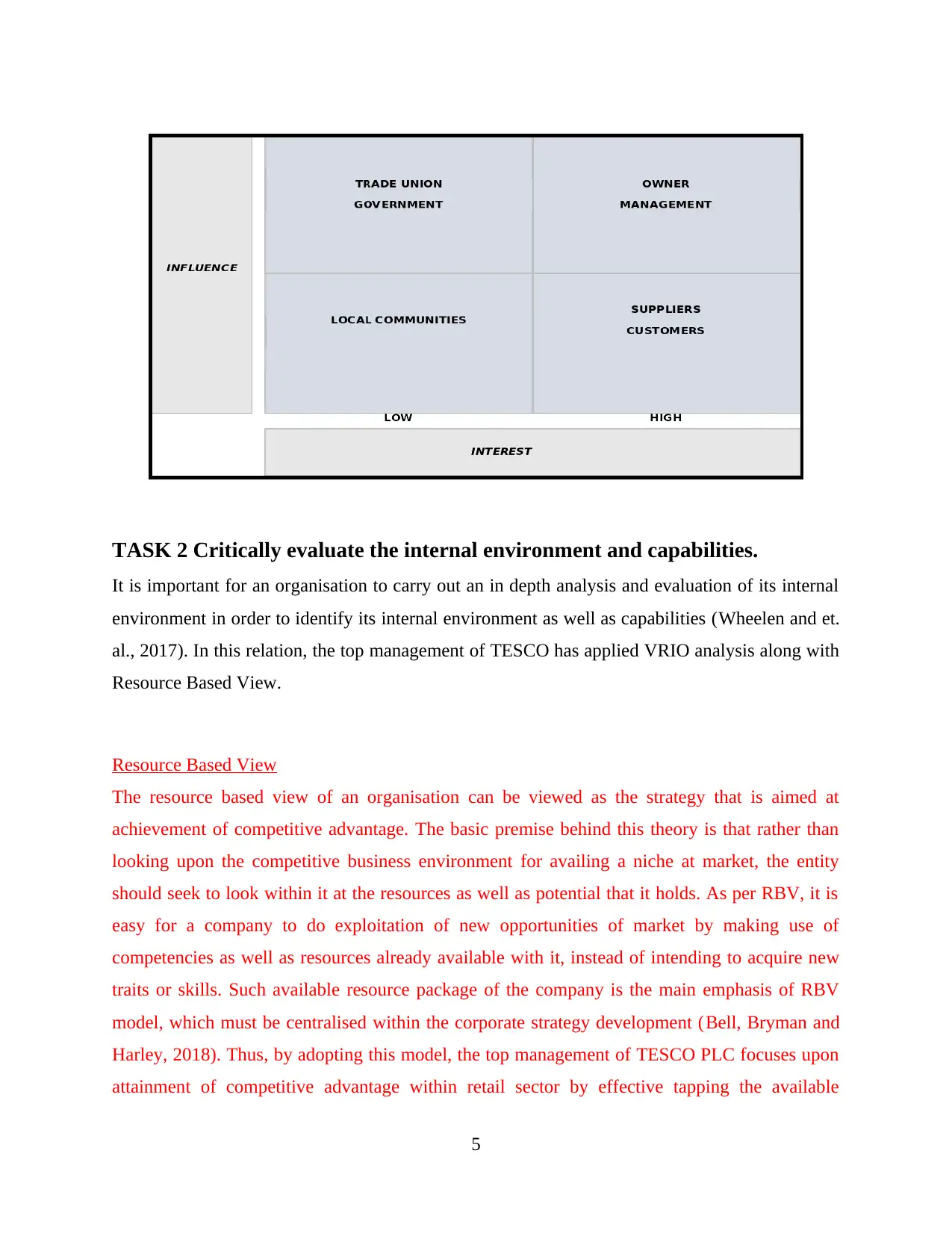
TASK 2 Critically evaluate the internal environment and capabilities.
It is important for an organisation to carry out an in depth analysis and evaluation of its internal
environment in order to identify its internal environment as well as capabilities (Wheelen and et.
al., 2017). In this relation, the top management of TESCO has applied VRIO analysis along with
Resource Based View.
Resource Based View
The resource based view of an organisation can be viewed as the strategy that is aimed at
achievement of competitive advantage. The basic premise behind this theory is that rather than
looking upon the competitive business environment for availing a niche at market, the entity
should seek to look within it at the resources as well as potential that it holds. As per RBV, it is
easy for a company to do exploitation of new opportunities of market by making use of
competencies as well as resources already available with it, instead of intending to acquire new
traits or skills. Such available resource package of the company is the main emphasis of RBV
model, which must be centralised within the corporate strategy development (Bell, Bryman and
Harley, 2018). Thus, by adopting this model, the top management of TESCO PLC focuses upon
attainment of competitive advantage within retail sector by effective tapping the available
5
It is important for an organisation to carry out an in depth analysis and evaluation of its internal
environment in order to identify its internal environment as well as capabilities (Wheelen and et.
al., 2017). In this relation, the top management of TESCO has applied VRIO analysis along with
Resource Based View.
Resource Based View
The resource based view of an organisation can be viewed as the strategy that is aimed at
achievement of competitive advantage. The basic premise behind this theory is that rather than
looking upon the competitive business environment for availing a niche at market, the entity
should seek to look within it at the resources as well as potential that it holds. As per RBV, it is
easy for a company to do exploitation of new opportunities of market by making use of
competencies as well as resources already available with it, instead of intending to acquire new
traits or skills. Such available resource package of the company is the main emphasis of RBV
model, which must be centralised within the corporate strategy development (Bell, Bryman and
Harley, 2018). Thus, by adopting this model, the top management of TESCO PLC focuses upon
attainment of competitive advantage within retail sector by effective tapping the available
5
Paraphrase This Document
Need a fresh take? Get an instant paraphrase of this document with our AI Paraphraser
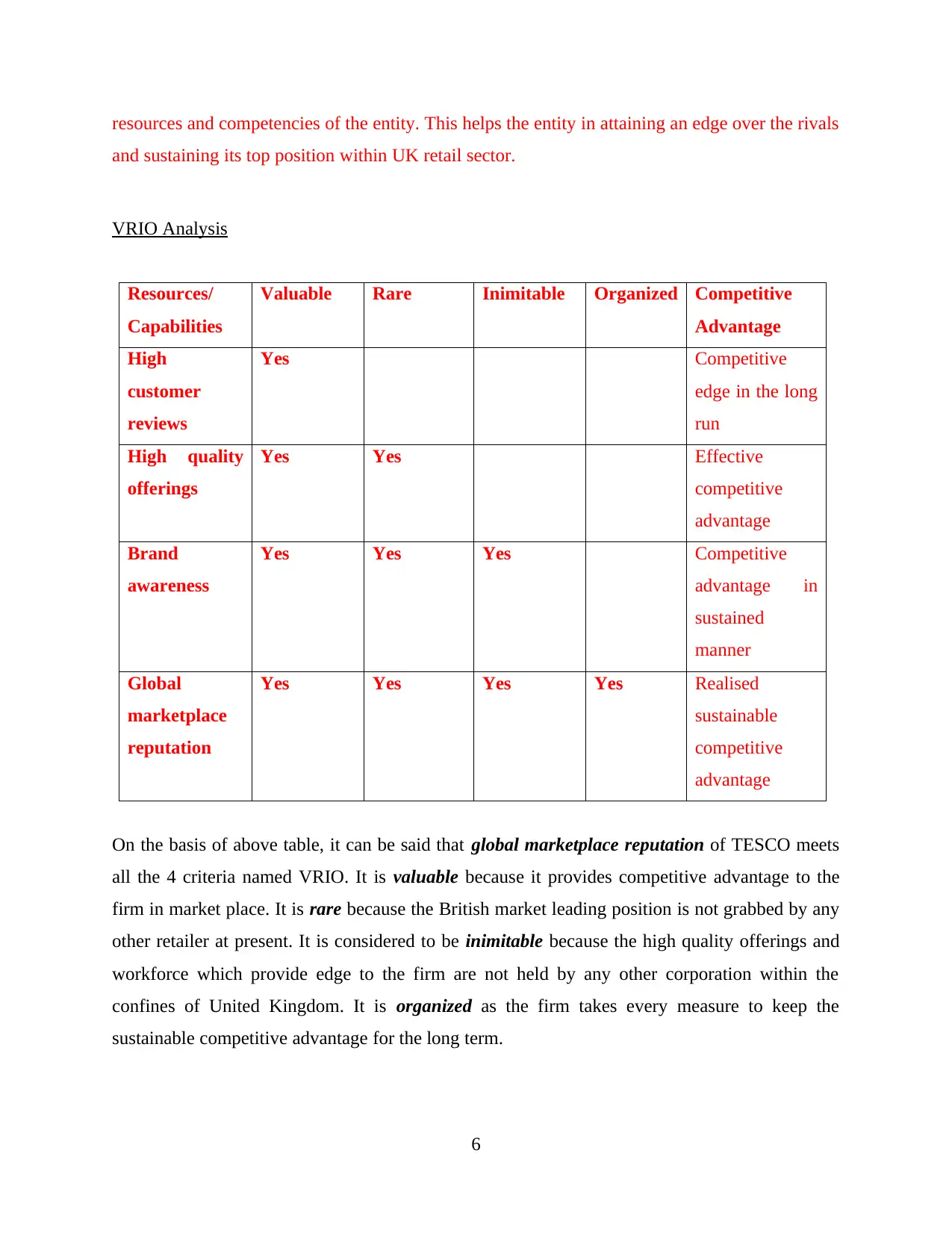
resources and competencies of the entity. This helps the entity in attaining an edge over the rivals
and sustaining its top position within UK retail sector.
VRIO Analysis
Resources/
Capabilities
Valuable Rare Inimitable Organized Competitive
Advantage
High
customer
reviews
Yes Competitive
edge in the long
run
High quality
offerings
Yes Yes Effective
competitive
advantage
Brand
awareness
Yes Yes Yes Competitive
advantage in
sustained
manner
Global
marketplace
reputation
Yes Yes Yes Yes Realised
sustainable
competitive
advantage
On the basis of above table, it can be said that global marketplace reputation of TESCO meets
all the 4 criteria named VRIO. It is valuable because it provides competitive advantage to the
firm in market place. It is rare because the British market leading position is not grabbed by any
other retailer at present. It is considered to be inimitable because the high quality offerings and
workforce which provide edge to the firm are not held by any other corporation within the
confines of United Kingdom. It is organized as the firm takes every measure to keep the
sustainable competitive advantage for the long term.
6
and sustaining its top position within UK retail sector.
VRIO Analysis
Resources/
Capabilities
Valuable Rare Inimitable Organized Competitive
Advantage
High
customer
reviews
Yes Competitive
edge in the long
run
High quality
offerings
Yes Yes Effective
competitive
advantage
Brand
awareness
Yes Yes Yes Competitive
advantage in
sustained
manner
Global
marketplace
reputation
Yes Yes Yes Yes Realised
sustainable
competitive
advantage
On the basis of above table, it can be said that global marketplace reputation of TESCO meets
all the 4 criteria named VRIO. It is valuable because it provides competitive advantage to the
firm in market place. It is rare because the British market leading position is not grabbed by any
other retailer at present. It is considered to be inimitable because the high quality offerings and
workforce which provide edge to the firm are not held by any other corporation within the
confines of United Kingdom. It is organized as the firm takes every measure to keep the
sustainable competitive advantage for the long term.
6
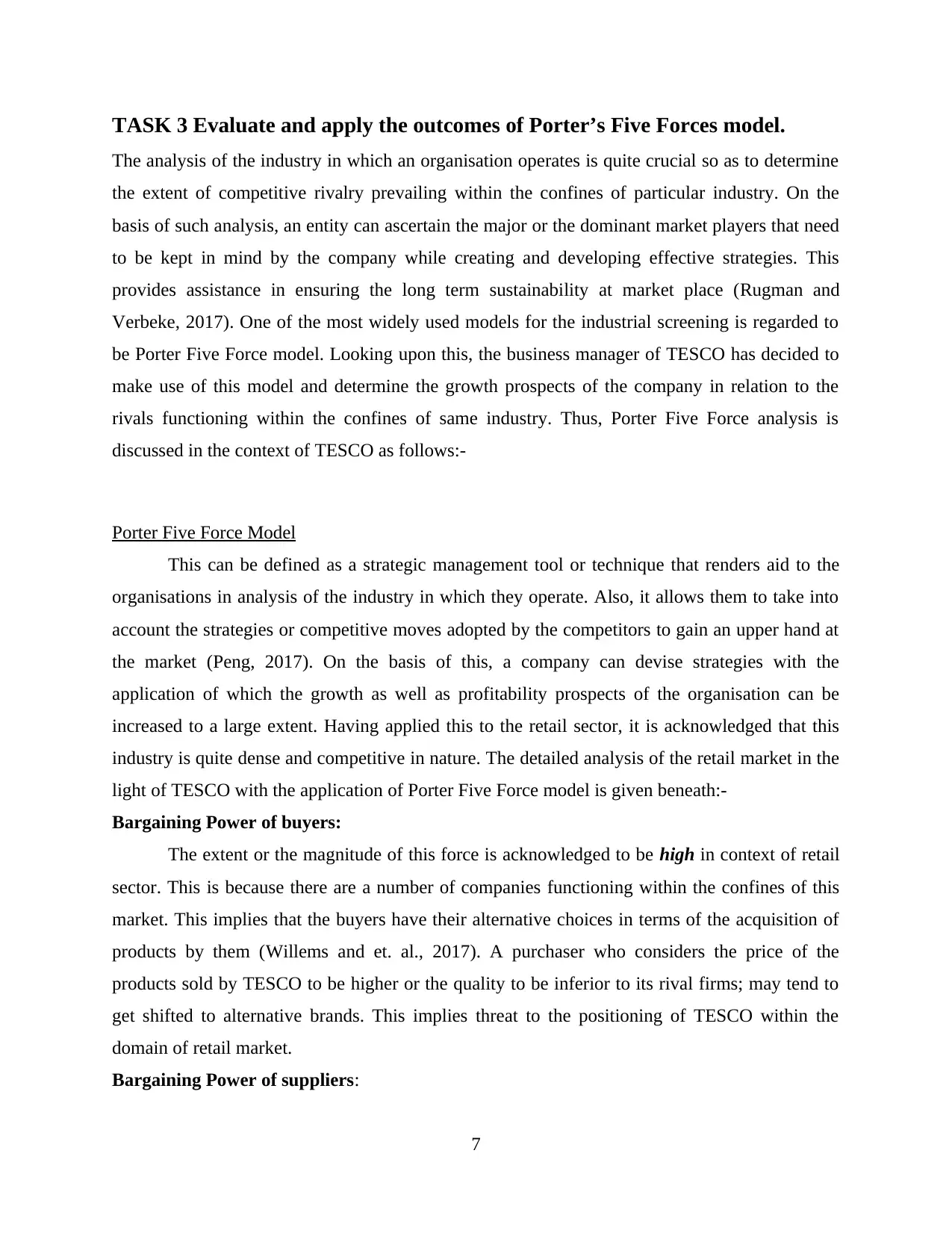
TASK 3 Evaluate and apply the outcomes of Porter’s Five Forces model.
The analysis of the industry in which an organisation operates is quite crucial so as to determine
the extent of competitive rivalry prevailing within the confines of particular industry. On the
basis of such analysis, an entity can ascertain the major or the dominant market players that need
to be kept in mind by the company while creating and developing effective strategies. This
provides assistance in ensuring the long term sustainability at market place (Rugman and
Verbeke, 2017). One of the most widely used models for the industrial screening is regarded to
be Porter Five Force model. Looking upon this, the business manager of TESCO has decided to
make use of this model and determine the growth prospects of the company in relation to the
rivals functioning within the confines of same industry. Thus, Porter Five Force analysis is
discussed in the context of TESCO as follows:-
Porter Five Force Model
This can be defined as a strategic management tool or technique that renders aid to the
organisations in analysis of the industry in which they operate. Also, it allows them to take into
account the strategies or competitive moves adopted by the competitors to gain an upper hand at
the market (Peng, 2017). On the basis of this, a company can devise strategies with the
application of which the growth as well as profitability prospects of the organisation can be
increased to a large extent. Having applied this to the retail sector, it is acknowledged that this
industry is quite dense and competitive in nature. The detailed analysis of the retail market in the
light of TESCO with the application of Porter Five Force model is given beneath:-
Bargaining Power of buyers:
The extent or the magnitude of this force is acknowledged to be high in context of retail
sector. This is because there are a number of companies functioning within the confines of this
market. This implies that the buyers have their alternative choices in terms of the acquisition of
products by them (Willems and et. al., 2017). A purchaser who considers the price of the
products sold by TESCO to be higher or the quality to be inferior to its rival firms; may tend to
get shifted to alternative brands. This implies threat to the positioning of TESCO within the
domain of retail market.
Bargaining Power of suppliers:
7
The analysis of the industry in which an organisation operates is quite crucial so as to determine
the extent of competitive rivalry prevailing within the confines of particular industry. On the
basis of such analysis, an entity can ascertain the major or the dominant market players that need
to be kept in mind by the company while creating and developing effective strategies. This
provides assistance in ensuring the long term sustainability at market place (Rugman and
Verbeke, 2017). One of the most widely used models for the industrial screening is regarded to
be Porter Five Force model. Looking upon this, the business manager of TESCO has decided to
make use of this model and determine the growth prospects of the company in relation to the
rivals functioning within the confines of same industry. Thus, Porter Five Force analysis is
discussed in the context of TESCO as follows:-
Porter Five Force Model
This can be defined as a strategic management tool or technique that renders aid to the
organisations in analysis of the industry in which they operate. Also, it allows them to take into
account the strategies or competitive moves adopted by the competitors to gain an upper hand at
the market (Peng, 2017). On the basis of this, a company can devise strategies with the
application of which the growth as well as profitability prospects of the organisation can be
increased to a large extent. Having applied this to the retail sector, it is acknowledged that this
industry is quite dense and competitive in nature. The detailed analysis of the retail market in the
light of TESCO with the application of Porter Five Force model is given beneath:-
Bargaining Power of buyers:
The extent or the magnitude of this force is acknowledged to be high in context of retail
sector. This is because there are a number of companies functioning within the confines of this
market. This implies that the buyers have their alternative choices in terms of the acquisition of
products by them (Willems and et. al., 2017). A purchaser who considers the price of the
products sold by TESCO to be higher or the quality to be inferior to its rival firms; may tend to
get shifted to alternative brands. This implies threat to the positioning of TESCO within the
domain of retail market.
Bargaining Power of suppliers:
7
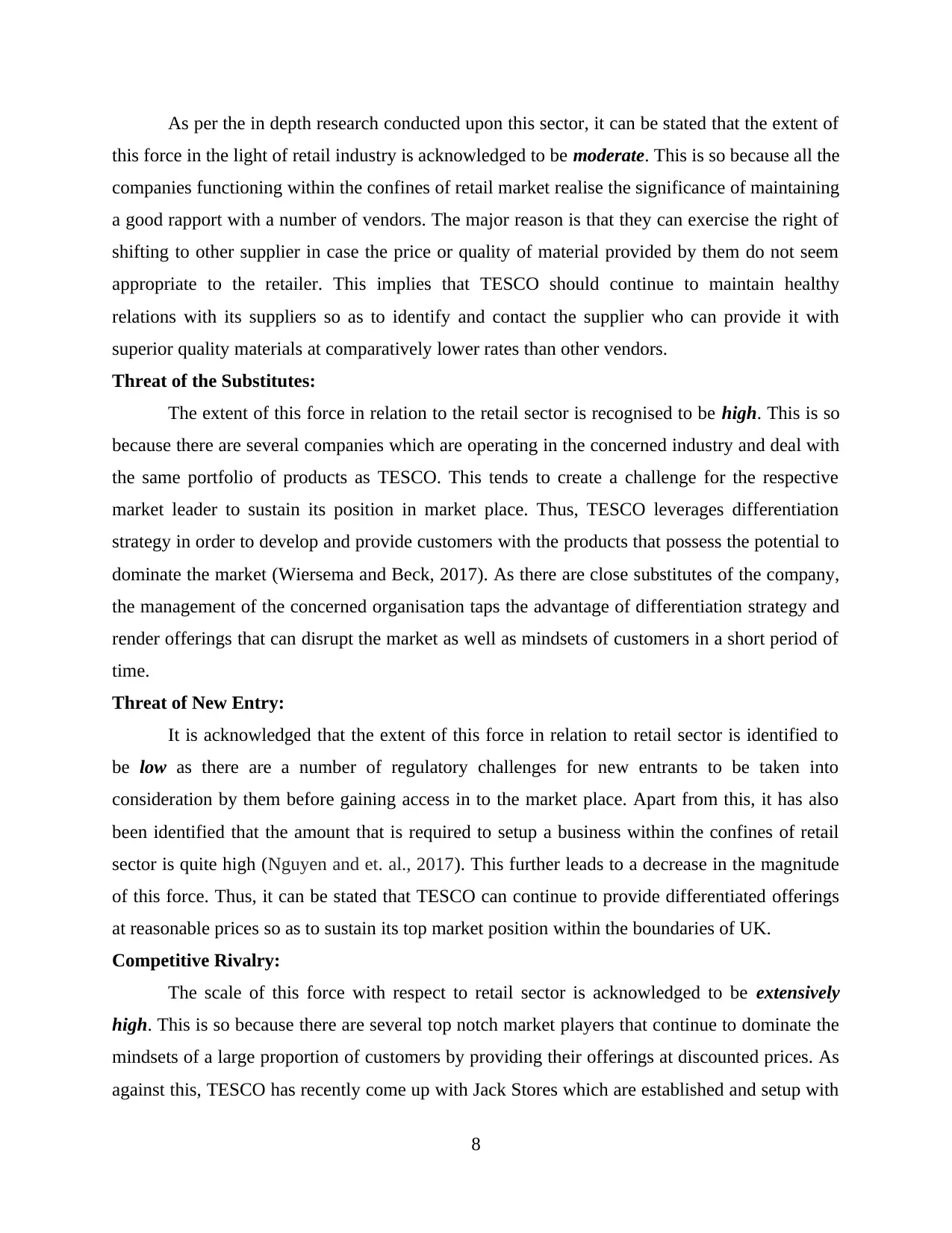
As per the in depth research conducted upon this sector, it can be stated that the extent of
this force in the light of retail industry is acknowledged to be moderate. This is so because all the
companies functioning within the confines of retail market realise the significance of maintaining
a good rapport with a number of vendors. The major reason is that they can exercise the right of
shifting to other supplier in case the price or quality of material provided by them do not seem
appropriate to the retailer. This implies that TESCO should continue to maintain healthy
relations with its suppliers so as to identify and contact the supplier who can provide it with
superior quality materials at comparatively lower rates than other vendors.
Threat of the Substitutes:
The extent of this force in relation to the retail sector is recognised to be high. This is so
because there are several companies which are operating in the concerned industry and deal with
the same portfolio of products as TESCO. This tends to create a challenge for the respective
market leader to sustain its position in market place. Thus, TESCO leverages differentiation
strategy in order to develop and provide customers with the products that possess the potential to
dominate the market (Wiersema and Beck, 2017). As there are close substitutes of the company,
the management of the concerned organisation taps the advantage of differentiation strategy and
render offerings that can disrupt the market as well as mindsets of customers in a short period of
time.
Threat of New Entry:
It is acknowledged that the extent of this force in relation to retail sector is identified to
be low as there are a number of regulatory challenges for new entrants to be taken into
consideration by them before gaining access in to the market place. Apart from this, it has also
been identified that the amount that is required to setup a business within the confines of retail
sector is quite high (Nguyen and et. al., 2017). This further leads to a decrease in the magnitude
of this force. Thus, it can be stated that TESCO can continue to provide differentiated offerings
at reasonable prices so as to sustain its top market position within the boundaries of UK.
Competitive Rivalry:
The scale of this force with respect to retail sector is acknowledged to be extensively
high. This is so because there are several top notch market players that continue to dominate the
mindsets of a large proportion of customers by providing their offerings at discounted prices. As
against this, TESCO has recently come up with Jack Stores which are established and setup with
8
this force in the light of retail industry is acknowledged to be moderate. This is so because all the
companies functioning within the confines of retail market realise the significance of maintaining
a good rapport with a number of vendors. The major reason is that they can exercise the right of
shifting to other supplier in case the price or quality of material provided by them do not seem
appropriate to the retailer. This implies that TESCO should continue to maintain healthy
relations with its suppliers so as to identify and contact the supplier who can provide it with
superior quality materials at comparatively lower rates than other vendors.
Threat of the Substitutes:
The extent of this force in relation to the retail sector is recognised to be high. This is so
because there are several companies which are operating in the concerned industry and deal with
the same portfolio of products as TESCO. This tends to create a challenge for the respective
market leader to sustain its position in market place. Thus, TESCO leverages differentiation
strategy in order to develop and provide customers with the products that possess the potential to
dominate the market (Wiersema and Beck, 2017). As there are close substitutes of the company,
the management of the concerned organisation taps the advantage of differentiation strategy and
render offerings that can disrupt the market as well as mindsets of customers in a short period of
time.
Threat of New Entry:
It is acknowledged that the extent of this force in relation to retail sector is identified to
be low as there are a number of regulatory challenges for new entrants to be taken into
consideration by them before gaining access in to the market place. Apart from this, it has also
been identified that the amount that is required to setup a business within the confines of retail
sector is quite high (Nguyen and et. al., 2017). This further leads to a decrease in the magnitude
of this force. Thus, it can be stated that TESCO can continue to provide differentiated offerings
at reasonable prices so as to sustain its top market position within the boundaries of UK.
Competitive Rivalry:
The scale of this force with respect to retail sector is acknowledged to be extensively
high. This is so because there are several top notch market players that continue to dominate the
mindsets of a large proportion of customers by providing their offerings at discounted prices. As
against this, TESCO has recently come up with Jack Stores which are established and setup with
8
Secure Best Marks with AI Grader
Need help grading? Try our AI Grader for instant feedback on your assignments.
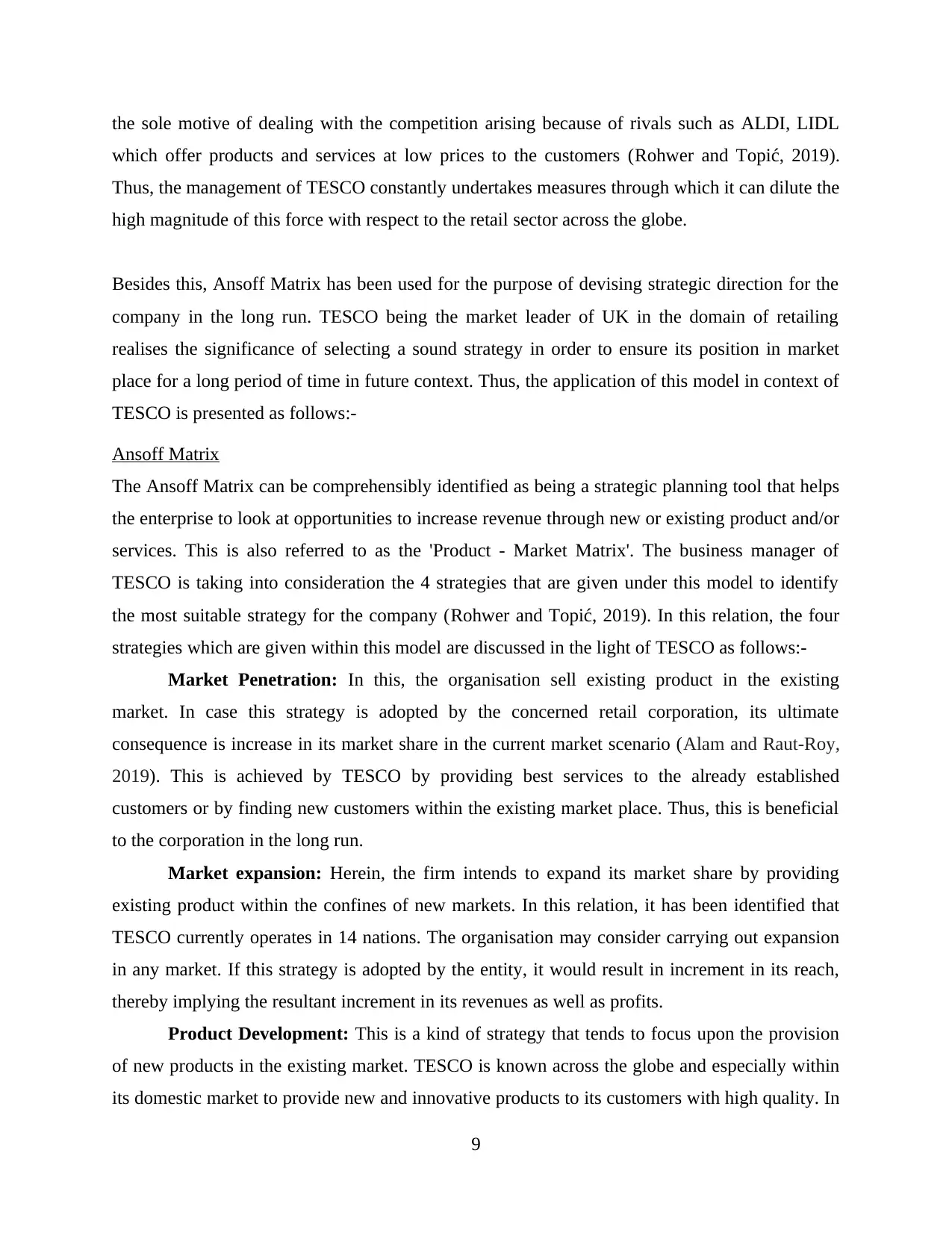
the sole motive of dealing with the competition arising because of rivals such as ALDI, LIDL
which offer products and services at low prices to the customers (Rohwer and Topić, 2019).
Thus, the management of TESCO constantly undertakes measures through which it can dilute the
high magnitude of this force with respect to the retail sector across the globe.
Besides this, Ansoff Matrix has been used for the purpose of devising strategic direction for the
company in the long run. TESCO being the market leader of UK in the domain of retailing
realises the significance of selecting a sound strategy in order to ensure its position in market
place for a long period of time in future context. Thus, the application of this model in context of
TESCO is presented as follows:-
Ansoff Matrix
The Ansoff Matrix can be comprehensibly identified as being a strategic planning tool that helps
the enterprise to look at opportunities to increase revenue through new or existing product and/or
services. This is also referred to as the 'Product - Market Matrix'. The business manager of
TESCO is taking into consideration the 4 strategies that are given under this model to identify
the most suitable strategy for the company (Rohwer and Topić, 2019). In this relation, the four
strategies which are given within this model are discussed in the light of TESCO as follows:-
Market Penetration: In this, the organisation sell existing product in the existing
market. In case this strategy is adopted by the concerned retail corporation, its ultimate
consequence is increase in its market share in the current market scenario (Alam and Raut-Roy,
2019). This is achieved by TESCO by providing best services to the already established
customers or by finding new customers within the existing market place. Thus, this is beneficial
to the corporation in the long run.
Market expansion: Herein, the firm intends to expand its market share by providing
existing product within the confines of new markets. In this relation, it has been identified that
TESCO currently operates in 14 nations. The organisation may consider carrying out expansion
in any market. If this strategy is adopted by the entity, it would result in increment in its reach,
thereby implying the resultant increment in its revenues as well as profits.
Product Development: This is a kind of strategy that tends to focus upon the provision
of new products in the existing market. TESCO is known across the globe and especially within
its domestic market to provide new and innovative products to its customers with high quality. In
9
which offer products and services at low prices to the customers (Rohwer and Topić, 2019).
Thus, the management of TESCO constantly undertakes measures through which it can dilute the
high magnitude of this force with respect to the retail sector across the globe.
Besides this, Ansoff Matrix has been used for the purpose of devising strategic direction for the
company in the long run. TESCO being the market leader of UK in the domain of retailing
realises the significance of selecting a sound strategy in order to ensure its position in market
place for a long period of time in future context. Thus, the application of this model in context of
TESCO is presented as follows:-
Ansoff Matrix
The Ansoff Matrix can be comprehensibly identified as being a strategic planning tool that helps
the enterprise to look at opportunities to increase revenue through new or existing product and/or
services. This is also referred to as the 'Product - Market Matrix'. The business manager of
TESCO is taking into consideration the 4 strategies that are given under this model to identify
the most suitable strategy for the company (Rohwer and Topić, 2019). In this relation, the four
strategies which are given within this model are discussed in the light of TESCO as follows:-
Market Penetration: In this, the organisation sell existing product in the existing
market. In case this strategy is adopted by the concerned retail corporation, its ultimate
consequence is increase in its market share in the current market scenario (Alam and Raut-Roy,
2019). This is achieved by TESCO by providing best services to the already established
customers or by finding new customers within the existing market place. Thus, this is beneficial
to the corporation in the long run.
Market expansion: Herein, the firm intends to expand its market share by providing
existing product within the confines of new markets. In this relation, it has been identified that
TESCO currently operates in 14 nations. The organisation may consider carrying out expansion
in any market. If this strategy is adopted by the entity, it would result in increment in its reach,
thereby implying the resultant increment in its revenues as well as profits.
Product Development: This is a kind of strategy that tends to focus upon the provision
of new products in the existing market. TESCO is known across the globe and especially within
its domestic market to provide new and innovative products to its customers with high quality. In
9
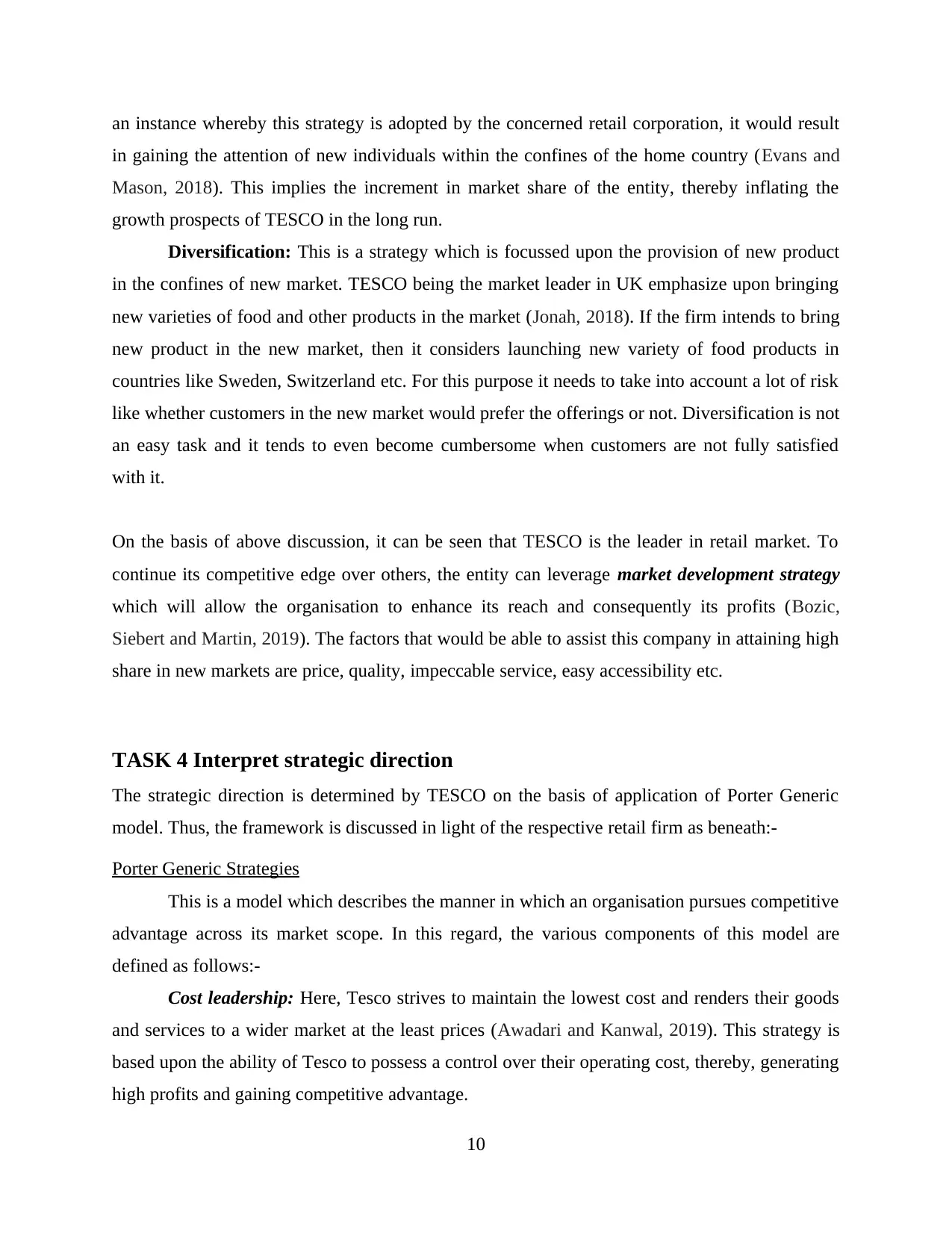
an instance whereby this strategy is adopted by the concerned retail corporation, it would result
in gaining the attention of new individuals within the confines of the home country (Evans and
Mason, 2018). This implies the increment in market share of the entity, thereby inflating the
growth prospects of TESCO in the long run.
Diversification: This is a strategy which is focussed upon the provision of new product
in the confines of new market. TESCO being the market leader in UK emphasize upon bringing
new varieties of food and other products in the market (Jonah, 2018). If the firm intends to bring
new product in the new market, then it considers launching new variety of food products in
countries like Sweden, Switzerland etc. For this purpose it needs to take into account a lot of risk
like whether customers in the new market would prefer the offerings or not. Diversification is not
an easy task and it tends to even become cumbersome when customers are not fully satisfied
with it.
On the basis of above discussion, it can be seen that TESCO is the leader in retail market. To
continue its competitive edge over others, the entity can leverage market development strategy
which will allow the organisation to enhance its reach and consequently its profits (Bozic,
Siebert and Martin, 2019). The factors that would be able to assist this company in attaining high
share in new markets are price, quality, impeccable service, easy accessibility etc.
TASK 4 Interpret strategic direction
The strategic direction is determined by TESCO on the basis of application of Porter Generic
model. Thus, the framework is discussed in light of the respective retail firm as beneath:-
Porter Generic Strategies
This is a model which describes the manner in which an organisation pursues competitive
advantage across its market scope. In this regard, the various components of this model are
defined as follows:-
Cost leadership: Here, Tesco strives to maintain the lowest cost and renders their goods
and services to a wider market at the least prices (Awadari and Kanwal, 2019). This strategy is
based upon the ability of Tesco to possess a control over their operating cost, thereby, generating
high profits and gaining competitive advantage.
10
in gaining the attention of new individuals within the confines of the home country (Evans and
Mason, 2018). This implies the increment in market share of the entity, thereby inflating the
growth prospects of TESCO in the long run.
Diversification: This is a strategy which is focussed upon the provision of new product
in the confines of new market. TESCO being the market leader in UK emphasize upon bringing
new varieties of food and other products in the market (Jonah, 2018). If the firm intends to bring
new product in the new market, then it considers launching new variety of food products in
countries like Sweden, Switzerland etc. For this purpose it needs to take into account a lot of risk
like whether customers in the new market would prefer the offerings or not. Diversification is not
an easy task and it tends to even become cumbersome when customers are not fully satisfied
with it.
On the basis of above discussion, it can be seen that TESCO is the leader in retail market. To
continue its competitive edge over others, the entity can leverage market development strategy
which will allow the organisation to enhance its reach and consequently its profits (Bozic,
Siebert and Martin, 2019). The factors that would be able to assist this company in attaining high
share in new markets are price, quality, impeccable service, easy accessibility etc.
TASK 4 Interpret strategic direction
The strategic direction is determined by TESCO on the basis of application of Porter Generic
model. Thus, the framework is discussed in light of the respective retail firm as beneath:-
Porter Generic Strategies
This is a model which describes the manner in which an organisation pursues competitive
advantage across its market scope. In this regard, the various components of this model are
defined as follows:-
Cost leadership: Here, Tesco strives to maintain the lowest cost and renders their goods
and services to a wider market at the least prices (Awadari and Kanwal, 2019). This strategy is
based upon the ability of Tesco to possess a control over their operating cost, thereby, generating
high profits and gaining competitive advantage.
10
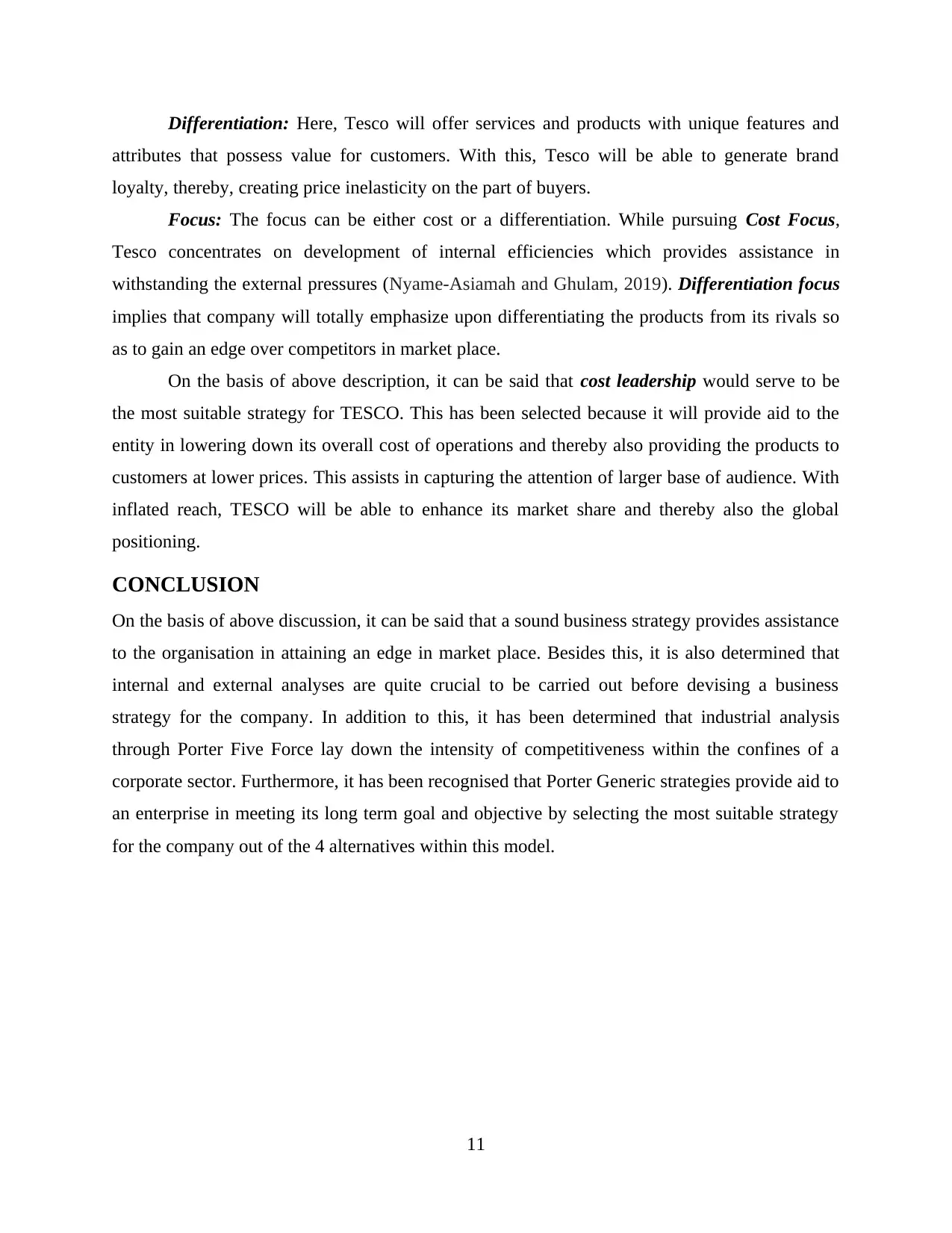
Differentiation: Here, Tesco will offer services and products with unique features and
attributes that possess value for customers. With this, Tesco will be able to generate brand
loyalty, thereby, creating price inelasticity on the part of buyers.
Focus: The focus can be either cost or a differentiation. While pursuing Cost Focus,
Tesco concentrates on development of internal efficiencies which provides assistance in
withstanding the external pressures (Nyame-Asiamah and Ghulam, 2019). Differentiation focus
implies that company will totally emphasize upon differentiating the products from its rivals so
as to gain an edge over competitors in market place.
On the basis of above description, it can be said that cost leadership would serve to be
the most suitable strategy for TESCO. This has been selected because it will provide aid to the
entity in lowering down its overall cost of operations and thereby also providing the products to
customers at lower prices. This assists in capturing the attention of larger base of audience. With
inflated reach, TESCO will be able to enhance its market share and thereby also the global
positioning.
CONCLUSION
On the basis of above discussion, it can be said that a sound business strategy provides assistance
to the organisation in attaining an edge in market place. Besides this, it is also determined that
internal and external analyses are quite crucial to be carried out before devising a business
strategy for the company. In addition to this, it has been determined that industrial analysis
through Porter Five Force lay down the intensity of competitiveness within the confines of a
corporate sector. Furthermore, it has been recognised that Porter Generic strategies provide aid to
an enterprise in meeting its long term goal and objective by selecting the most suitable strategy
for the company out of the 4 alternatives within this model.
11
attributes that possess value for customers. With this, Tesco will be able to generate brand
loyalty, thereby, creating price inelasticity on the part of buyers.
Focus: The focus can be either cost or a differentiation. While pursuing Cost Focus,
Tesco concentrates on development of internal efficiencies which provides assistance in
withstanding the external pressures (Nyame-Asiamah and Ghulam, 2019). Differentiation focus
implies that company will totally emphasize upon differentiating the products from its rivals so
as to gain an edge over competitors in market place.
On the basis of above description, it can be said that cost leadership would serve to be
the most suitable strategy for TESCO. This has been selected because it will provide aid to the
entity in lowering down its overall cost of operations and thereby also providing the products to
customers at lower prices. This assists in capturing the attention of larger base of audience. With
inflated reach, TESCO will be able to enhance its market share and thereby also the global
positioning.
CONCLUSION
On the basis of above discussion, it can be said that a sound business strategy provides assistance
to the organisation in attaining an edge in market place. Besides this, it is also determined that
internal and external analyses are quite crucial to be carried out before devising a business
strategy for the company. In addition to this, it has been determined that industrial analysis
through Porter Five Force lay down the intensity of competitiveness within the confines of a
corporate sector. Furthermore, it has been recognised that Porter Generic strategies provide aid to
an enterprise in meeting its long term goal and objective by selecting the most suitable strategy
for the company out of the 4 alternatives within this model.
11
Paraphrase This Document
Need a fresh take? Get an instant paraphrase of this document with our AI Paraphraser
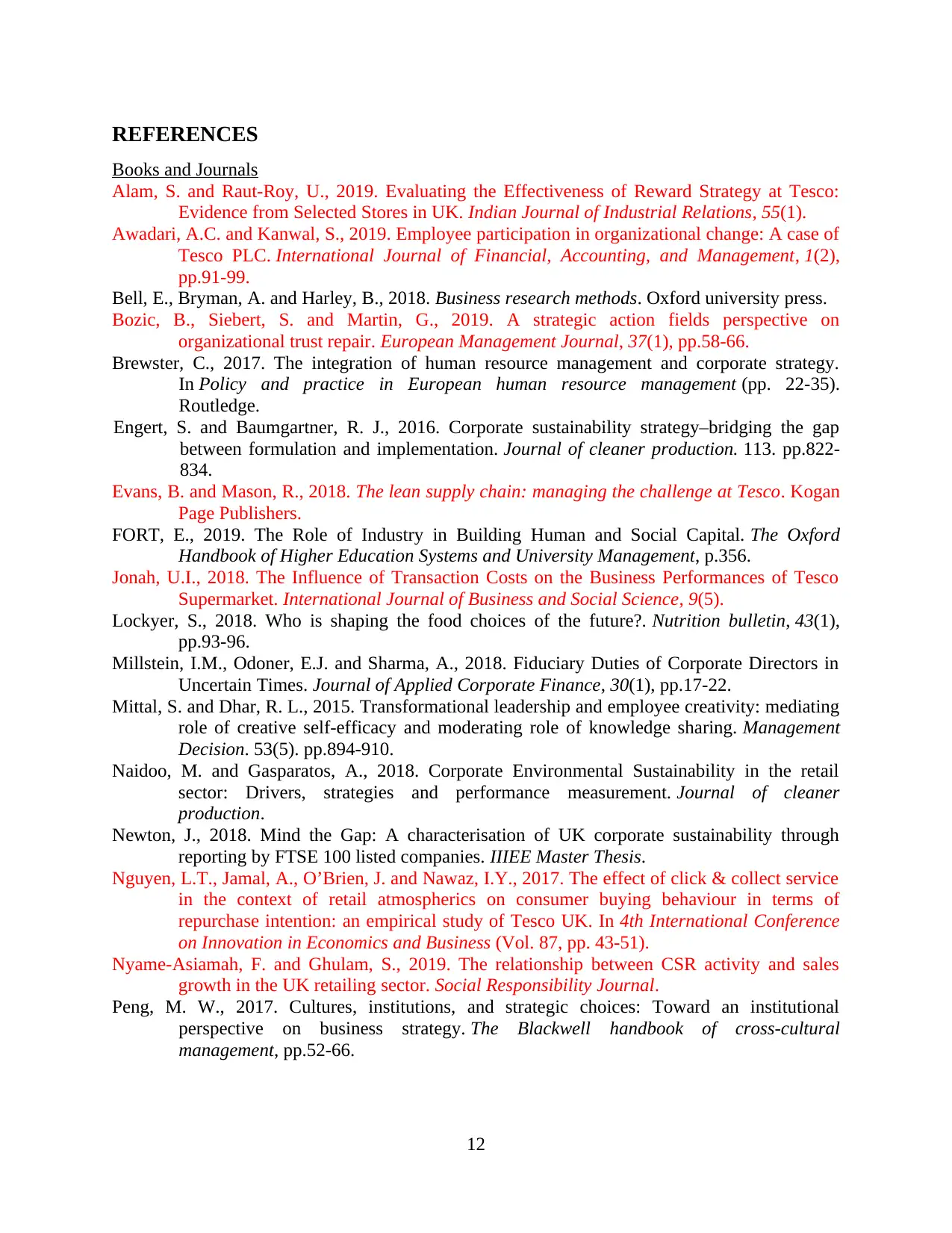
REFERENCES
Books and Journals
Alam, S. and Raut-Roy, U., 2019. Evaluating the Effectiveness of Reward Strategy at Tesco:
Evidence from Selected Stores in UK. Indian Journal of Industrial Relations, 55(1).
Awadari, A.C. and Kanwal, S., 2019. Employee participation in organizational change: A case of
Tesco PLC. International Journal of Financial, Accounting, and Management, 1(2),
pp.91-99.
Bell, E., Bryman, A. and Harley, B., 2018. Business research methods. Oxford university press.
Bozic, B., Siebert, S. and Martin, G., 2019. A strategic action fields perspective on
organizational trust repair. European Management Journal, 37(1), pp.58-66.
Brewster, C., 2017. The integration of human resource management and corporate strategy.
In Policy and practice in European human resource management (pp. 22-35).
Routledge.
Engert, S. and Baumgartner, R. J., 2016. Corporate sustainability strategy–bridging the gap
between formulation and implementation. Journal of cleaner production. 113. pp.822-
834.
Evans, B. and Mason, R., 2018. The lean supply chain: managing the challenge at Tesco. Kogan
Page Publishers.
FORT, E., 2019. The Role of Industry in Building Human and Social Capital. The Oxford
Handbook of Higher Education Systems and University Management, p.356.
Jonah, U.I., 2018. The Influence of Transaction Costs on the Business Performances of Tesco
Supermarket. International Journal of Business and Social Science, 9(5).
Lockyer, S., 2018. Who is shaping the food choices of the future?. Nutrition bulletin, 43(1),
pp.93-96.
Millstein, I.M., Odoner, E.J. and Sharma, A., 2018. Fiduciary Duties of Corporate Directors in
Uncertain Times. Journal of Applied Corporate Finance, 30(1), pp.17-22.
Mittal, S. and Dhar, R. L., 2015. Transformational leadership and employee creativity: mediating
role of creative self-efficacy and moderating role of knowledge sharing. Management
Decision. 53(5). pp.894-910.
Naidoo, M. and Gasparatos, A., 2018. Corporate Environmental Sustainability in the retail
sector: Drivers, strategies and performance measurement. Journal of cleaner
production.
Newton, J., 2018. Mind the Gap: A characterisation of UK corporate sustainability through
reporting by FTSE 100 listed companies. IIIEE Master Thesis.
Nguyen, L.T., Jamal, A., O’Brien, J. and Nawaz, I.Y., 2017. The effect of click & collect service
in the context of retail atmospherics on consumer buying behaviour in terms of
repurchase intention: an empirical study of Tesco UK. In 4th International Conference
on Innovation in Economics and Business (Vol. 87, pp. 43-51).
Nyame-Asiamah, F. and Ghulam, S., 2019. The relationship between CSR activity and sales
growth in the UK retailing sector. Social Responsibility Journal.
Peng, M. W., 2017. Cultures, institutions, and strategic choices: Toward an institutional
perspective on business strategy. The Blackwell handbook of cross‐cultural
management, pp.52-66.
12
Books and Journals
Alam, S. and Raut-Roy, U., 2019. Evaluating the Effectiveness of Reward Strategy at Tesco:
Evidence from Selected Stores in UK. Indian Journal of Industrial Relations, 55(1).
Awadari, A.C. and Kanwal, S., 2019. Employee participation in organizational change: A case of
Tesco PLC. International Journal of Financial, Accounting, and Management, 1(2),
pp.91-99.
Bell, E., Bryman, A. and Harley, B., 2018. Business research methods. Oxford university press.
Bozic, B., Siebert, S. and Martin, G., 2019. A strategic action fields perspective on
organizational trust repair. European Management Journal, 37(1), pp.58-66.
Brewster, C., 2017. The integration of human resource management and corporate strategy.
In Policy and practice in European human resource management (pp. 22-35).
Routledge.
Engert, S. and Baumgartner, R. J., 2016. Corporate sustainability strategy–bridging the gap
between formulation and implementation. Journal of cleaner production. 113. pp.822-
834.
Evans, B. and Mason, R., 2018. The lean supply chain: managing the challenge at Tesco. Kogan
Page Publishers.
FORT, E., 2019. The Role of Industry in Building Human and Social Capital. The Oxford
Handbook of Higher Education Systems and University Management, p.356.
Jonah, U.I., 2018. The Influence of Transaction Costs on the Business Performances of Tesco
Supermarket. International Journal of Business and Social Science, 9(5).
Lockyer, S., 2018. Who is shaping the food choices of the future?. Nutrition bulletin, 43(1),
pp.93-96.
Millstein, I.M., Odoner, E.J. and Sharma, A., 2018. Fiduciary Duties of Corporate Directors in
Uncertain Times. Journal of Applied Corporate Finance, 30(1), pp.17-22.
Mittal, S. and Dhar, R. L., 2015. Transformational leadership and employee creativity: mediating
role of creative self-efficacy and moderating role of knowledge sharing. Management
Decision. 53(5). pp.894-910.
Naidoo, M. and Gasparatos, A., 2018. Corporate Environmental Sustainability in the retail
sector: Drivers, strategies and performance measurement. Journal of cleaner
production.
Newton, J., 2018. Mind the Gap: A characterisation of UK corporate sustainability through
reporting by FTSE 100 listed companies. IIIEE Master Thesis.
Nguyen, L.T., Jamal, A., O’Brien, J. and Nawaz, I.Y., 2017. The effect of click & collect service
in the context of retail atmospherics on consumer buying behaviour in terms of
repurchase intention: an empirical study of Tesco UK. In 4th International Conference
on Innovation in Economics and Business (Vol. 87, pp. 43-51).
Nyame-Asiamah, F. and Ghulam, S., 2019. The relationship between CSR activity and sales
growth in the UK retailing sector. Social Responsibility Journal.
Peng, M. W., 2017. Cultures, institutions, and strategic choices: Toward an institutional
perspective on business strategy. The Blackwell handbook of cross‐cultural
management, pp.52-66.
12
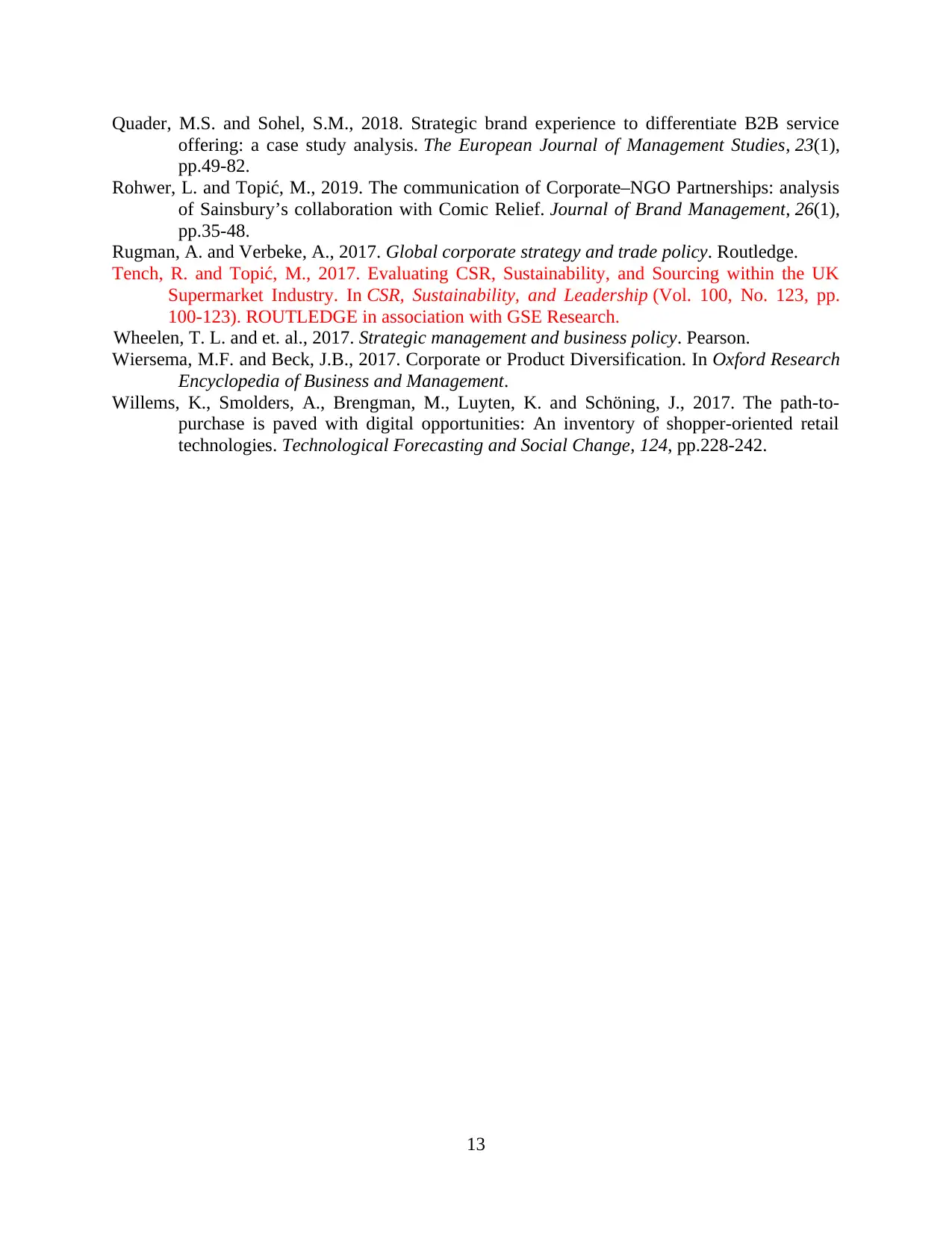
Quader, M.S. and Sohel, S.M., 2018. Strategic brand experience to differentiate B2B service
offering: a case study analysis. The European Journal of Management Studies, 23(1),
pp.49-82.
Rohwer, L. and Topić, M., 2019. The communication of Corporate–NGO Partnerships: analysis
of Sainsbury’s collaboration with Comic Relief. Journal of Brand Management, 26(1),
pp.35-48.
Rugman, A. and Verbeke, A., 2017. Global corporate strategy and trade policy. Routledge.
Tench, R. and Topić, M., 2017. Evaluating CSR, Sustainability, and Sourcing within the UK
Supermarket Industry. In CSR, Sustainability, and Leadership (Vol. 100, No. 123, pp.
100-123). ROUTLEDGE in association with GSE Research.
Wheelen, T. L. and et. al., 2017. Strategic management and business policy. Pearson.
Wiersema, M.F. and Beck, J.B., 2017. Corporate or Product Diversification. In Oxford Research
Encyclopedia of Business and Management.
Willems, K., Smolders, A., Brengman, M., Luyten, K. and Schöning, J., 2017. The path-to-
purchase is paved with digital opportunities: An inventory of shopper-oriented retail
technologies. Technological Forecasting and Social Change, 124, pp.228-242.
13
offering: a case study analysis. The European Journal of Management Studies, 23(1),
pp.49-82.
Rohwer, L. and Topić, M., 2019. The communication of Corporate–NGO Partnerships: analysis
of Sainsbury’s collaboration with Comic Relief. Journal of Brand Management, 26(1),
pp.35-48.
Rugman, A. and Verbeke, A., 2017. Global corporate strategy and trade policy. Routledge.
Tench, R. and Topić, M., 2017. Evaluating CSR, Sustainability, and Sourcing within the UK
Supermarket Industry. In CSR, Sustainability, and Leadership (Vol. 100, No. 123, pp.
100-123). ROUTLEDGE in association with GSE Research.
Wheelen, T. L. and et. al., 2017. Strategic management and business policy. Pearson.
Wiersema, M.F. and Beck, J.B., 2017. Corporate or Product Diversification. In Oxford Research
Encyclopedia of Business and Management.
Willems, K., Smolders, A., Brengman, M., Luyten, K. and Schöning, J., 2017. The path-to-
purchase is paved with digital opportunities: An inventory of shopper-oriented retail
technologies. Technological Forecasting and Social Change, 124, pp.228-242.
13
1 out of 15
Related Documents
Your All-in-One AI-Powered Toolkit for Academic Success.
+13062052269
info@desklib.com
Available 24*7 on WhatsApp / Email
![[object Object]](/_next/static/media/star-bottom.7253800d.svg)
Unlock your academic potential
© 2024 | Zucol Services PVT LTD | All rights reserved.





